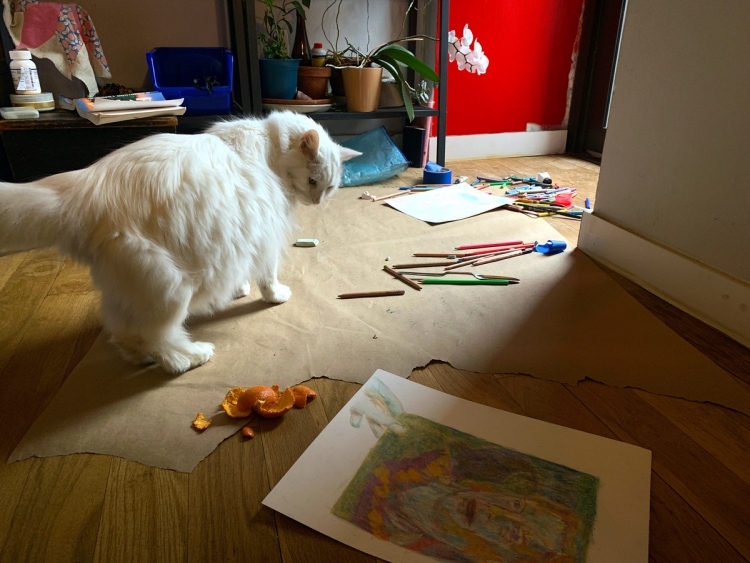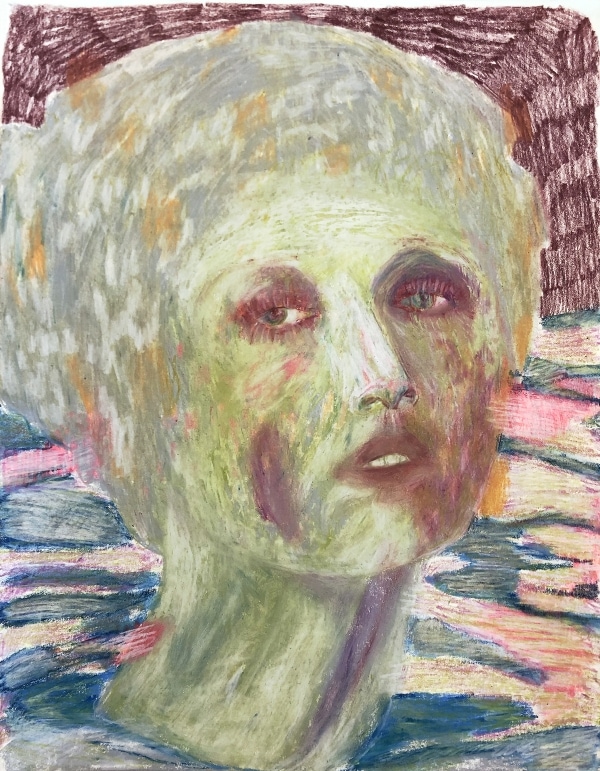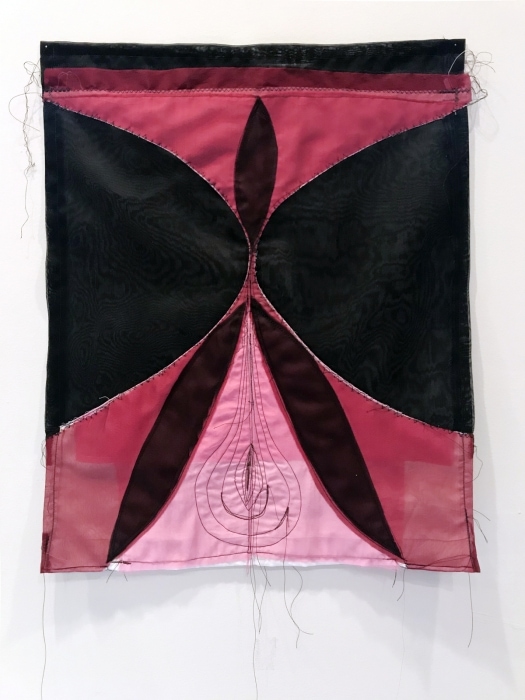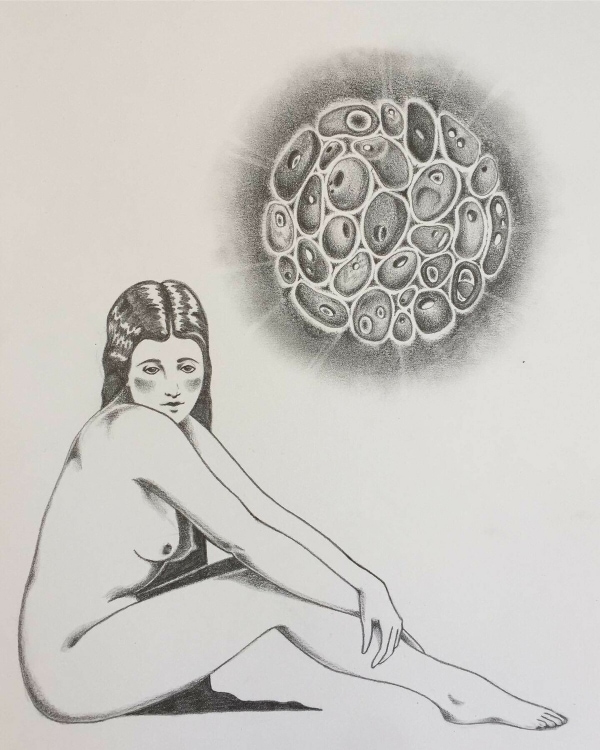Interview with Loren Erdrich, Annette Hur, Larissa Borteh and Mira Manella
The big front window of my home studio looks out onto a park. Through it I’ve watched the seasons change, branches of snow to buds to leaves. Recently the fields of grass became sprinkled yellow, so fleeting is the life of a dandelion that less than a week later they all went white and fluffy and disappeared. Each day, I push the curtains aside to see what mother nature is presenting us.
73 days and nights have passed since the day of the week has seemed to serve any purpose. Hello new day! whoever you are. My morning routine has become more of a dance than a vacant muscle memory. I am more present than ever for the placement of the top sheet over the fitted sheet, and look forward to that moment of it hovering before it lands in just the right place, or not. And the thrill of the Tetris like game that I always win while loading the dishwasher. Life is what it is now. I understand and submit to my home’s boundaries like never before. I’ve become domesticated, I am a house cat now.
The memories of it are fading but I remember the elation of waking up to a day off, the initial shock and excitement that turns to a pressure to use it wisely. Home is now the singular setting for my everyday life. It is the space in which I am placed, stationed, waiting, hoping, trying to imagine the reopening of the city, the look and feel of that future. I have no idea how I will undo the house cat I’ve become, I’m sure I will be skittish, whine and hiss but I will try not to worry about that now. Because this month’s article is optimistic like the open arms of home after venturing out to the grocery store. Home sweet home! Home, a refuge from the unmasked, invincible, fool hearted, inconsiderate humans. Its conception was inspired by a Cate Le Bon song Home to You, which I have been humming for weeks and the comfort and longing that the word ‘home’ implies when sung in so many songs. I’ve asked four artists; Loren Erdrich, Annette Hur, Larissa Borteh and Mira Manella to talk about their concept of home and their ever evolving relationship with it over these stationary times within its four walls.
Loren Erdrich
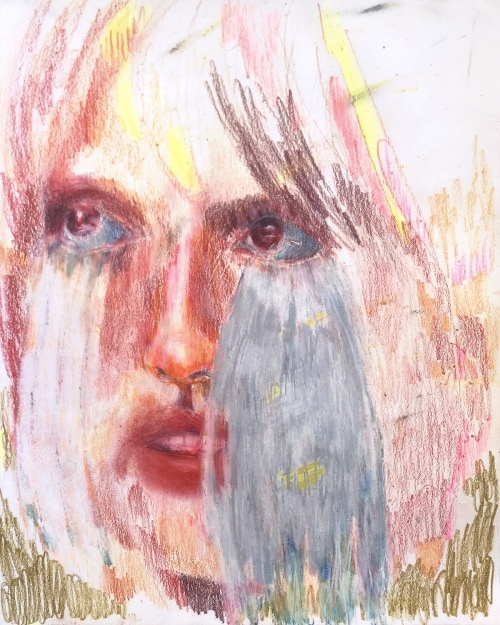
Isolation Drawing 15 (I Don't Even Cry That Much Anymore), 14 x 11", colored pencil and watercolor crayon on paper, 2020.
Amanda Joy Calobrisi: Who are you and what do you do?
Loren Erdrich: I am a visual artist living in NY, NY. I’ve had a studio based in Bushwick, Brooklyn since 2011. I make paintings, drawings and sculptures that celebrate vulnerability. I’m always looking to dissolve the spaces between things - outside/inside, me/you, this world/the other-worldly.
Amanda Joy Calobrisi: What is home to you?
Loren Erdrich: In a sense home is a fairly new concept to me. In my twenties and early thirties, I moved around constantly - from place to place, art residency to art residency, country to country. In a very real sense I made and remade my physical home with each move. I focused very little on the actual place I inhabited in the physical sense, since I never embraced where I was long enough to put down roots. I think home at that point truly resided in a box full of precious objects that came with me on each move; rocks I'd collected from places I had been, shells, old buttons, pieces of rusted metal I'd found, a toy from a Kinder Surprise, a charm for a necklace and my favorite books. These things gave me a sense of comfort, being known, and consistency. With those things in my possession, I didn't take issue with the fact that my physical living space was totally bare and transitory. It's only in the past few years that home has begun to mean something different. It began by staying still, by committing to the place where I found myself. Now I see my home reflected less in the objects I hold and more in the sense of sanctuary that cradles me when I enter it. Mostly this sense is non-physical - it is rooted in the feeling of being seen, accepted and supported. But it also exists in the sense of ownership I feel over my physical space, in the plants and art that make this place a joy to live, in the choices and changes I have made and continue to make that deepen my connection to this place.
Amanda Joy Calobrisi: How has your home played a role in who you are and what you do? Has this evolved since being at home has become mandatory?
Loren Erdrich: Though in recent years the concept of home has meant more to me than it ever has before, I'm still someone who spends most of her time away from the house. I've never been someone that looks forward to a day lounging inside. I suppose my sense of self is tied up in being active. Plus, I live in a very small apartment with my husband who works from home making it imperative to have a studio elsewhere. So this period in isolation, with the focus on remaining at home, has been a big change for me. In March and April, we had so much rain in NYC that it was difficult to get to my studio by bike and that, coupled with a general sense of fear and malaise, meant a lot of working from home. After rearranging a bit of furniture, we created a small space near a glass door that lets in great morning light. In this space I've been working on small drawings. Drawing wasn't a large part of my practice before but it has become my focus during this time since the materials required are easily transported between home and studio. Over the past few months I've become more and more comfortable being still. I've found different ways to challenge myself and feel active, but I've also found real pleasure in a quieter calmer life.
Amanda Joy Calobrisi: How have you made peace with the idea of another month or longer in this place called home? Have you taken on new projects, overdue or newly imagined to occupy this time?
Loren Erdrich: This is a physically, emotionally and mentally difficult time for most of the world but I have also been able to find positive moments in it. Despite my usual habits, my studio work really thrives in isolated natural surroundings, I often go on residency to places like rural Ireland, Wyoming, or Nebraska to find this. During the COVID19 outbreak I've been able to access this quietness here in NYC which is completely strange. In general, I feel more ownership of my home. It's like this time has allowed me to claim my place in my apartment, my neighborhood, and my city.
As my days have slowed down I have made a point to try to be more present. When I go on a walk I try to notice the things I've never seen before despite living here for years. I'm still not someone that finds pleasure in occupying herself with a million little things around the house but when I’m not drawing I've been reading, updating my website, documenting work and working on applications. I think one of the hardest things about this time period has been how nebulous and confusing it all feels and how hard it is to discern what is really happening since it is a new experience for everyone. I keep searching for 'facts' and the facts keep changing. Therefore, I've been so grateful to consider my home a sanctuary from all the madness, because I know that is not the case for everyone.
Amanda Joy Calobrisi: Finally share that book, movie, or album that will forever be associated with this quarantine of 2020.
Loren Erdrich: I finally read Circe by Madeline Miller this month. It is about a strange goddess exiled to a deserted island and her centuries long journey to find her true self within this isolation. I love things that turn my attention to alternate points of view within myths or parables we think we know so well.
Annette Hur
Amanda Joy Calobrisi: Who are you and what do you do?
Annette Hur: My name is Annette Hur, and I’m an artist in Brooklyn NY.
Amanda Joy Calobrisi: What is home to you?
Annette Hur: For me and probably for a lot of people, home is a heavy, emotionally charged word. I’ve called my good friends ‘homies’ and called someone a ‘homewrecker’, and when I’ve said ‘homesick’, I mean my friends and family in Korea rather than an apartment previously lived in.
I’m originally from South Korea and, in Korea, we don’t use the word ‘homeless’ for people who do not have a house to sleep in. Instead, we call people in this situation ‘street-boarding-person(s)’. I prefer the Korean word because of its directness and perhaps its lack of emotional charge.
Probably because I have moved almost every year since 2011, both in Korea and in the US, to me, the word home doesn't necessarily imply a physical space, but is instead where I want to come back to both consciously and subconsciously. In 2006 home was Denver Colorado, in 2009-2010 it was the children that I taught and loved very much and in 2011-2019, it was my dog.
In recent years, I have also called my art studio a second home because painting/ the canvas is what I want to return to most of the days. I guess my concept of 'home' is located somewhere between ‘love’ and ’belonging’.
However, since the world is suffering from a pandemic, physical homes have become our air raid shelters against the invisible enemy, and we all have been developing not only a new emotional relationship (love it or hate it) but also a very physical relationship with it, and I am still working on that one.
Amanda Joy Calobrisi: How has your home played a role in who you are and what you do? Has this evolved since being at home has become mandatory?
Annette Hur: I was introduced to abstraction when I moved to the US and I have always thought that the way I use it and continually return to it in my work is related to the way I long for a psychological home. In Korea I was trained to paint representationally; my art education consisted of100 percent observational paintings. The process of learning how to understand and use abstraction in my work has been liberating, it feels like I am finally on my way to a place where I truly belong. Abstraction to me is where I can assimilate, imitate, reveal and expose by working against a system that is known and typical. It is also the place that I want to come back to, anytime and feel safe.
In terms of a physical home, I don't think it has affected my practice as much as my psychological home has. Due to the pandemic, I have not been able to go to my studio for almost two months, so I have been only working on textiles at home. This situation has been mentally challenging for two reasons, not being able to return to my 'painting home'(headspace) and having to do so much cooking, every day in the same space that I am making the work.
Amanda Joy Calobrisi: How have you made peace with the idea of another month or longer in this place called home? Have you taken on new projects, overdue or newly imagined to occupy this time?
Annette Hur: For the past month, working on Korean silk collage has been my home sport. It has definitely been meditative and helpful to ease some of the anxiety. I have been also working on some online exhibitions and an online viewing room for a gallery website, but honestly, taking those online opportunities as seriously as I would have the physical in-person exhibitions hasn't been easy. I am losing my current studio at the end of this month due to the current crisis, but I was lucky to find a live work space from mid-June. It will be my first official long term live/work space. While a part of me is uncertain about the sudden change, most of me is very much looking forward to it. I’m very excited to return to painting every day.
Amanda Joy Calobrisi: Finally share that book, movie, or album that will forever be associated with this quarantine of 2020.
Annette Hur: Minor Feelings by Cathy Park Hong
Larissa Borteh
Amanda Joy Calobrisi: Who are you and what do you do?
Larissa Borteh: My name is Larissa Borteh, I am an artist currently living and working in Chicago, Illinois. I am primarily an oil painter, but I also make drawings, prints, and work with water-based media such as watercolor, ink, and gouache.
Amanda Joy Calobrisi: What is home to you?
Larissa Borteh: Home to me is more of a mental space of comfort where I can check in with myself and find refuge from the swirling stresses and distractions of daily life. I can feel not at home in my physical home if my place is a mess, my bed is unmade, and my dishes are unwashed. I can feel at home in a different country where I don’t know the language, but I have some delicious fruits and a comfortable shirt. I can also feel at home talking with a familiar person or being active in my body by riding my bike or making a drawing.
Amanda Joy Calobrisi: How has your home played a role in who you are and what you do? Has this evolved since being at home has become mandatory?
Larissa Borteh: My apartment has always been a place for me to decompress after a busy day and turn my brain to a quieter frequency. I try to be present in my space and not bring my day home with me where events can play out on a loop. My job and studio are both outside of my home, so it was easy for me to compartmentalize my time. I would usually come home from work or the studio, make dinner, maybe watch a show or read a book, sometimes draw, and then go to bed.
Now that we are under the stay-at-home order, home has become my office, my studio, my stress, my sleep, my relaxation, my distraction, and my safety net. It has helped me to have different spots in my home where I can focus on different tasks, otherwise all my thoughts marinate together and I get distracted.
I’ve rearranged my space a couple of times during quarantine, but I have found that I really like painting and doing work at my kitchen table, because it has the best light. There is a big window in my kitchen that looks out onto a busy street where a coffee shop across the way has been painting and repainting its façade vivid new colors every few days. It has been nice to watch the time pass through each paint job.
Amanda Joy Calobrisi: How have you made peace with the idea of another month or longer in this place called home? Have you taken on new projects, overdue or newly imagined to occupy this time?
Larissa Borteh: I am at peace with being inside for as long as we need to stay safe. At this point I feel like I have adapted the best I can and I will continue to adapt and make changes every day. I have been trying to read as much as I can and make art every day, though sometimes it doesn’t always happen.
I started making a series of water-based paintings from life of different objects and spaces in my apartment. I love working from life and I always tell myself “when I have more time, I am going to work from life and make some studies!”, but of course it never happens. It always gets put on the backburner in favor of tasks that need more immediate attention. These interior studies have been so fun to make and they have removed some of the pressure of having to invent things on the surface. Painting from observation has been a good way for me to stay present by really focusing on what I’m seeing and the process of painting rather than having to do a lot of mental gymnastics.
I plan on making more works from observation, and I will begin working on some paintings and drawings that derive from a combination of invention and observation. By working in these two different modes, I am hoping to build a bridge where one method of working can inform the other and to continue developing the sense of light and space in my work. With the limitations of not being in my usual studio setup, I am using this time as an incubator for things to come.
Amanda Joy Calobrisi: Finally share that book, movie, or album that will forever be associated with the quarantine of 2020.
Larissa Borteh: Fiona Apple – Fetch The Bolt Cutters
Mira Manella

Self-Portrait in Studio Mirror “I spend a lot of time sitting on the floor in my studio. The red curtains give it a nice glow all day, it’s kind of like a womb in here.”
Amanda Joy Calobrisi: Who are you and what do you do?
Mira Manella: I am Mira and I do many things.
Amanda Joy Calobrisi: What is home to you?
Mira Manella: Home is where I live. It's an accumulation of all the places I've been and all the things I've done. My stuff is there, my dog is there, my partner is there. I can close the door and say goodbye to outside obligations and tune out. Day-job work stress can stay at work, something I am grateful for and home can be a place of solace and mental clarity. I can take time to focus and get centered and maybe make some dinner. Or, I can crash and burn and cry a little and fall asleep. I can do whatever I want, it's my house.
Amanda Joy Calobrisi: How has your home played a role in who you are and what you do? Has this evolved since being at home has become mandatory?
Mira Manella: My home has always doubled as my studio, whether I’ve had the space for it or not. I moved into my current apartment almost a year ago and it’s the first time I’ve ever had ample space for art making. I’ve spent lots of time since moving in trying to perfect my studio space, and this quarantine has given me enough time to really transform it into something I can be comfortable and productive in. But I still do lots of work on the couch in front of the TV, on the floor, in bed, and whichever room has the most sun.
Amanda Joy Calobrisi: How have you made peace with the idea of another month or longer in this place called home? Have you taken on new projects, overdue or newly imagined to occupy this time?
Mira Manella: I enthusiastically made peace with staying home the moment the order was put in place. I really do love being home. It’s the other things we’ve lost like seeing friends, going to the beach, filling my car up with gas, feeling safe and unseen in public spaces, etc., that really cause me anxiety. It has manifested in wanting to clean and rearrange things constantly, so I’ve redone my studio five times and done hours and hours of scrolling through images of vintage rugs that I can’t afford. I now know how long it takes for the hallway to fill with clumps of dog hair between vacuum sessions. I brush my shag rug once every two weeks like it was another pet. I’ve done so many dishes that I wonder why we even have so many. It’s been a little hard. However, this extended time with no work or social obligations has given me so much insight into what I want, what I need, and what I like. I started painting again for the first time in about 8 years. I’ve completed drawings from start to finish. My partner and I started a garden. I found a way to loosen my grip on my own expectations and enjoy making art again. This really horrible time in the world has given me an opportunity for growth, and I am extremely grateful for that privilege.
Amanda Joy Calobrisi: Finally share that book, movie, or album that will forever be associated with the quarantine of 2020.
Mira Manella: I finally took the plunge and watched True Blood and it was such a strange journey. I don’t think I’ll ever get the theme song out of my head.

 English
English 日本語
日本語